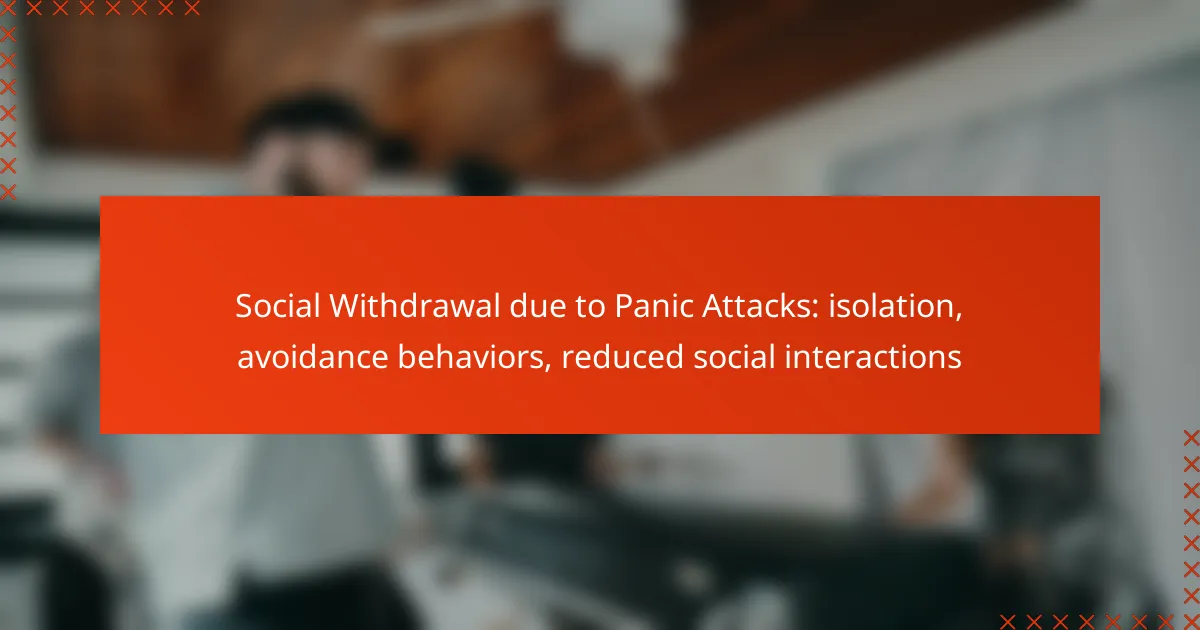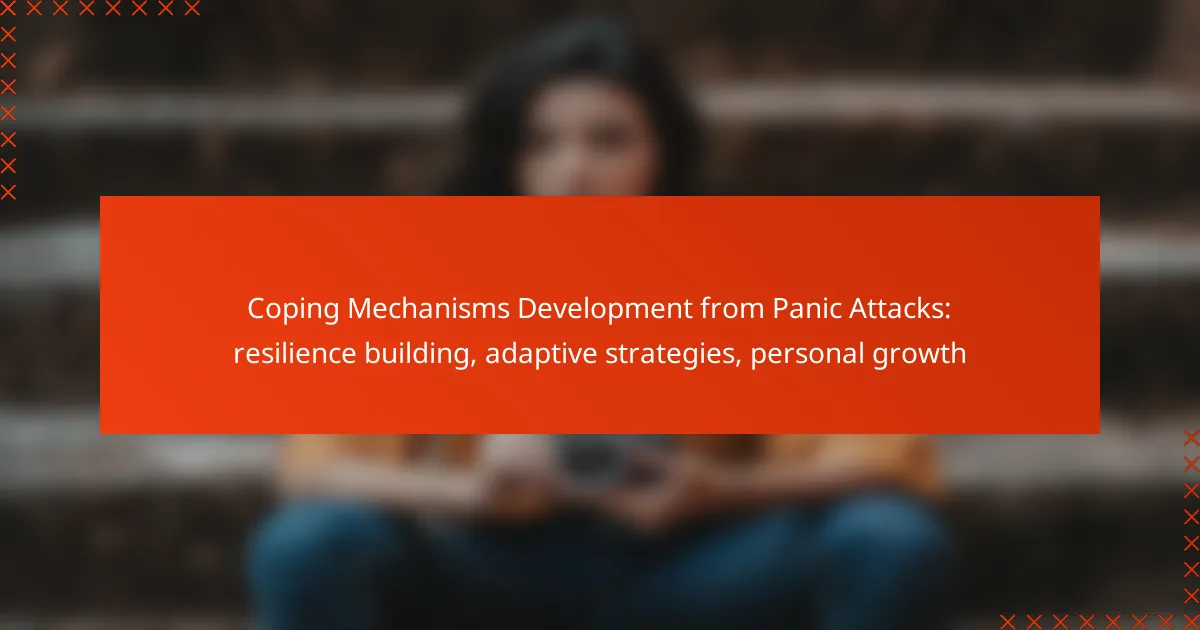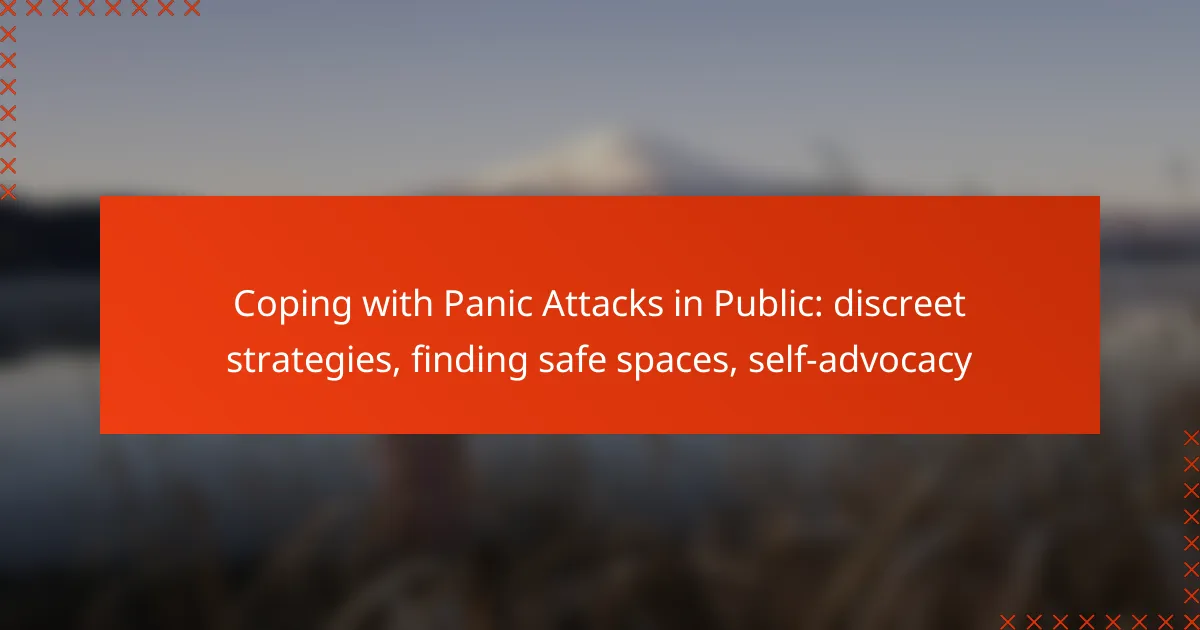Social withdrawal due to panic attacks can lead to significant isolation and avoidance behaviors, as individuals often steer clear of situations that may trigger their anxiety. This retreat from social interactions not only exacerbates feelings of loneliness but can also contribute to a decline in overall mental health. Addressing these challenges requires a multifaceted approach, including therapy, medication, and support systems to help individuals regain their confidence and re-engage with their communities.
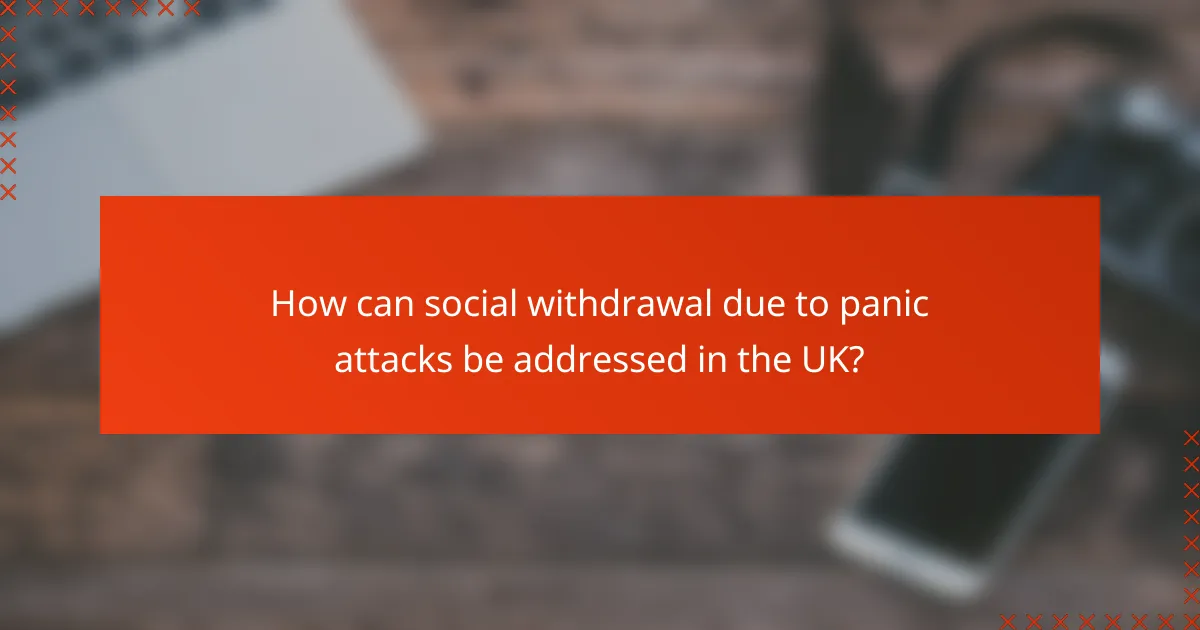
How can social withdrawal due to panic attacks be addressed in the UK?
Addressing social withdrawal from panic attacks in the UK involves a combination of therapeutic approaches, medication, and support systems. Effective strategies include Cognitive Behavioral Therapy (CBT), medication options, support groups, mindfulness techniques, and gradual exposure therapy.
Cognitive Behavioral Therapy (CBT)
Cognitive Behavioral Therapy (CBT) is a structured, time-limited therapy that helps individuals identify and change negative thought patterns contributing to panic attacks and social withdrawal. It typically involves weekly sessions over several months, focusing on coping strategies and behavioral changes.
In the UK, CBT is often available through the National Health Service (NHS) or private practitioners. Many people find that regular practice of CBT techniques can significantly reduce anxiety and improve social interactions over time.
Medication options
Medication can be an effective option for managing panic attacks and reducing social withdrawal. Common medications include selective serotonin reuptake inhibitors (SSRIs) and benzodiazepines, which can help alleviate anxiety symptoms.
Consulting with a healthcare provider is essential to determine the most appropriate medication, as responses can vary. It’s important to discuss potential side effects and the duration of treatment to find a suitable balance.
Support groups in the UK
Support groups provide a safe space for individuals experiencing panic attacks and social withdrawal to share their experiences and coping strategies. In the UK, organizations like Anxiety UK and Mind offer local support groups and online forums.
Joining a support group can foster a sense of community and reduce feelings of isolation. Participants often report feeling more understood and empowered to face social situations together.
Mindfulness techniques
Mindfulness techniques, such as meditation and deep-breathing exercises, can help manage anxiety and improve emotional regulation. Practicing mindfulness encourages individuals to stay present and reduces the tendency to avoid social situations due to fear of panic attacks.
Incorporating mindfulness into daily routines can be simple, requiring just a few minutes each day. Apps like Headspace or Calm can guide users through mindfulness practices tailored for anxiety management.
Gradual exposure therapy
Gradual exposure therapy involves slowly and systematically facing feared social situations to reduce anxiety over time. This method helps individuals build confidence and resilience in social settings, countering avoidance behaviors.
In the UK, therapists often guide clients through this process, starting with less intimidating scenarios and gradually progressing to more challenging situations. Keeping a journal of experiences can help track progress and reinforce positive outcomes.

What are the common avoidance behaviors associated with panic attacks?
Common avoidance behaviors linked to panic attacks include actions taken to prevent situations that may trigger anxiety. These behaviors often lead to increased isolation and reduced social interactions, as individuals seek to avoid environments where they fear experiencing panic symptoms.
Avoiding crowded places
Avoiding crowded places is a prevalent behavior among those experiencing panic attacks. Individuals may feel overwhelmed in large gatherings, fearing they could lose control or have a panic episode. This avoidance can lead to missing out on social events, which further exacerbates feelings of isolation.
Examples of crowded places include shopping malls, concerts, and public transportation. To manage this, individuals might start by visiting less crowded locations or going during off-peak hours to gradually build confidence.
Staying home frequently
Staying home frequently is another common avoidance behavior that can stem from panic attacks. Many individuals find comfort in the safety of their homes, leading to a cycle of isolation. While this may provide temporary relief, it can ultimately hinder social skills and increase feelings of loneliness.
To counteract this behavior, setting small, achievable goals for going out can be helpful. For instance, planning short outings to familiar places can ease anxiety and encourage gradual re-engagement with the outside world.
Limiting social interactions
Limiting social interactions is a typical response to the fear of panic attacks. Individuals may decline invitations or withdraw from friendships to avoid potential triggers. This behavior can strain relationships and contribute to a sense of disconnection from others.
To address this, individuals can communicate their struggles to friends and family, fostering understanding and support. Additionally, starting with low-pressure social situations, such as small gatherings, can help rebuild confidence in social settings.
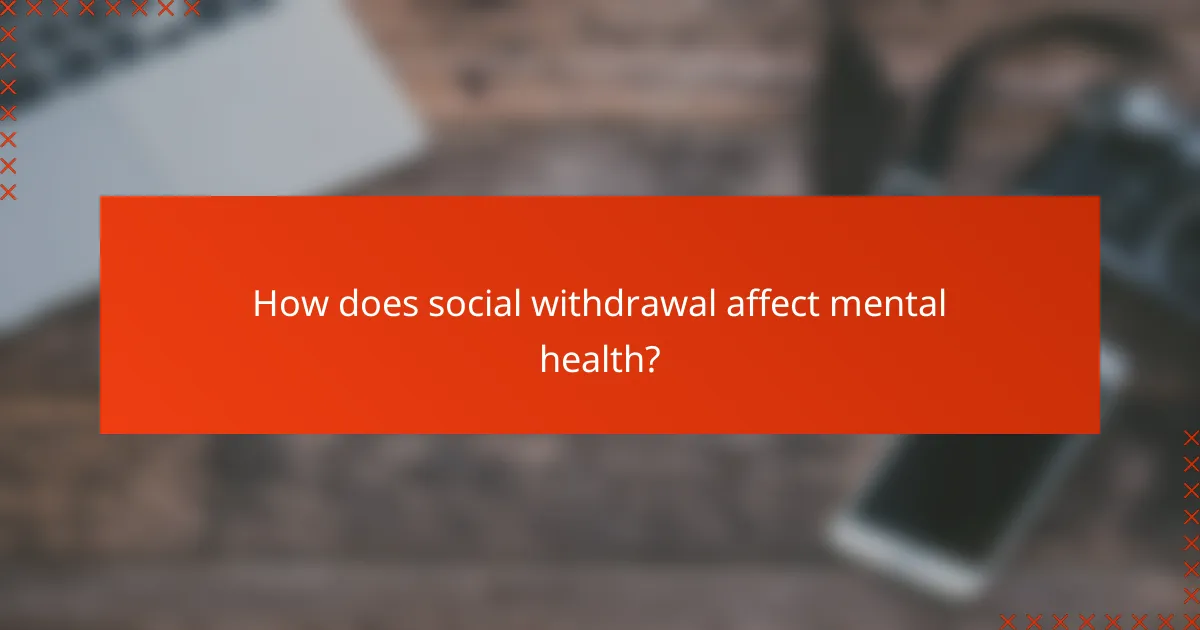
How does social withdrawal affect mental health?
Social withdrawal can significantly impact mental health by exacerbating feelings of isolation and increasing the risk of developing more severe psychological issues. When individuals retreat from social interactions, they often experience a decline in emotional well-being and a heightened sense of loneliness.
Increased feelings of loneliness
Social withdrawal leads to heightened feelings of loneliness, as individuals miss out on meaningful connections and interactions. This isolation can create a vicious cycle, where the lack of social engagement further deepens feelings of solitude.
Over time, loneliness can become chronic, contributing to a sense of despair and making it increasingly difficult to reach out for help. Engaging in even small social activities can help mitigate these feelings and foster a sense of belonging.
Worsening anxiety symptoms
Withdrawal from social situations often results in worsening anxiety symptoms. The avoidance of social interactions may provide temporary relief but can reinforce fears and anxieties associated with those situations.
As anxiety escalates, individuals may find themselves trapped in a cycle of avoidance, where the thought of socializing becomes increasingly daunting. Gradually exposing oneself to social settings, even in small doses, can help alleviate this anxiety over time.
Potential for depression
Prolonged social withdrawal can lead to an increased risk of depression. The lack of social support and interaction can diminish mood and motivation, making it challenging to engage in daily activities.
Recognizing the signs of depression early is crucial. Individuals should consider seeking professional help or support groups to address their feelings and re-establish connections with others. Regularly participating in social activities, even when it feels difficult, can be a proactive step toward improving mental health.
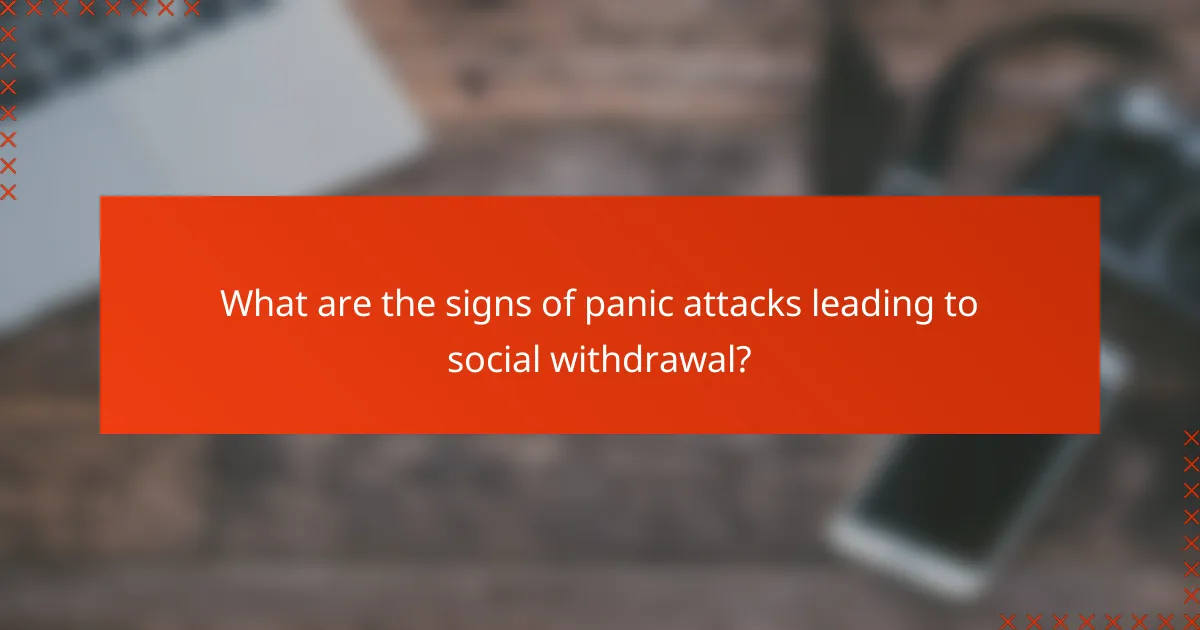
What are the signs of panic attacks leading to social withdrawal?
Panic attacks can trigger social withdrawal, characterized by avoidance behaviors and reduced social interactions. Individuals may experience intense fear and anxiety, leading them to isolate themselves from social situations to prevent triggering an attack.
Physical symptoms during social situations
During social situations, individuals may experience a range of physical symptoms that can be overwhelming. Common symptoms include rapid heartbeat, sweating, trembling, and shortness of breath. These sensations can create a strong urge to escape the environment, reinforcing the tendency to withdraw from social interactions.
Fear of judgment from others
Fear of being judged or misunderstood by others can significantly contribute to social withdrawal. Individuals may worry that their panic attacks will be perceived as weakness or that others will not understand their condition. This fear can lead to avoidance of gatherings, meetings, or any social event where they might feel scrutinized.
Anticipatory anxiety
Anticipatory anxiety refers to the intense worry about potential future panic attacks in social settings. This anxiety can start days or weeks before an event, causing individuals to decline invitations or avoid planning outings altogether. Recognizing this pattern is crucial, as it can perpetuate a cycle of isolation and increase feelings of loneliness.
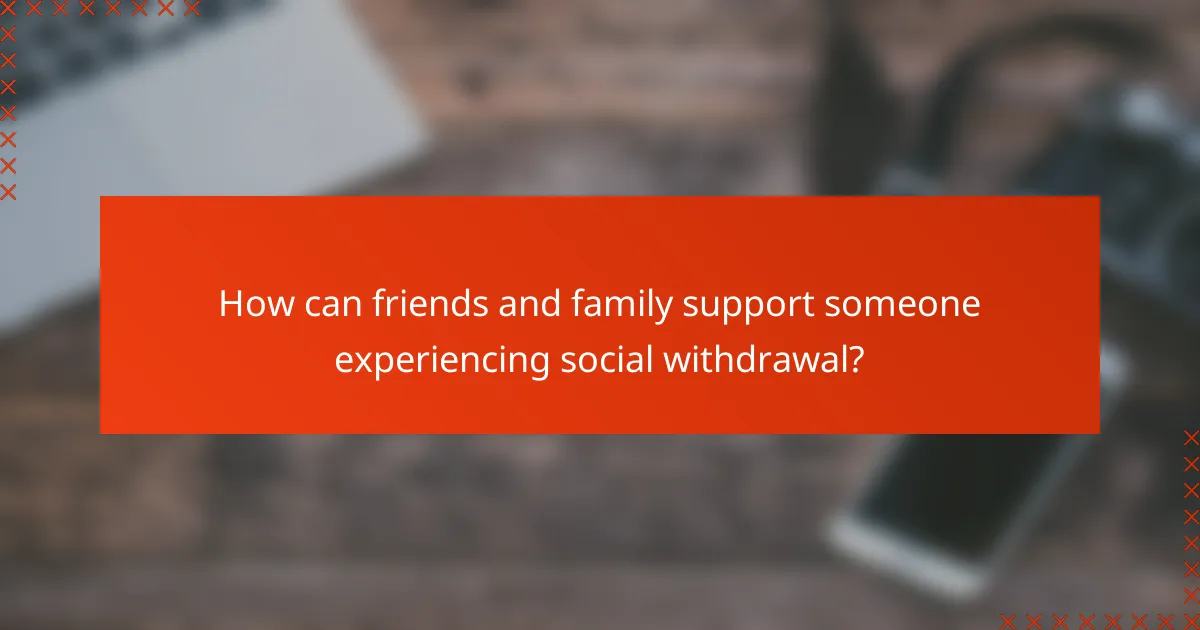
How can friends and family support someone experiencing social withdrawal?
Friends and family can play a crucial role in supporting someone facing social withdrawal due to panic attacks by fostering a safe and understanding environment. Their encouragement and patience can help the individual feel less isolated and more connected to social interactions.
Encouraging open communication
Open communication is vital for individuals experiencing social withdrawal. Encourage them to express their feelings and fears without judgment, which can help reduce anxiety about sharing their experiences. Active listening and validating their emotions can strengthen trust and openness.
Consider setting aside regular times to talk, ensuring the individual feels comfortable and safe. This can be a simple coffee chat or a walk in a quiet park, where they can share their thoughts more freely.
Offering to accompany them to social events
Offering to accompany someone to social events can significantly ease their anxiety. Knowing they have a supportive companion can make the prospect of socializing less daunting. Start with smaller gatherings where the pressure is lower, such as a family dinner or a small get-together with close friends.
Be flexible and ready to adapt plans based on their comfort level. If they feel overwhelmed, it’s important to respect their need to leave early or skip certain events altogether.
Understanding their triggers
Understanding the specific triggers that lead to panic attacks is essential for providing effective support. Take the time to learn about their unique experiences and what situations may provoke anxiety. This knowledge can help you avoid inadvertently placing them in stressful scenarios.
Encourage them to identify and communicate their triggers, and work together to develop strategies for managing these situations. This could include practicing relaxation techniques or having a plan for when they start to feel anxious.
